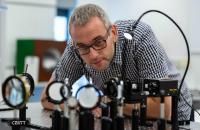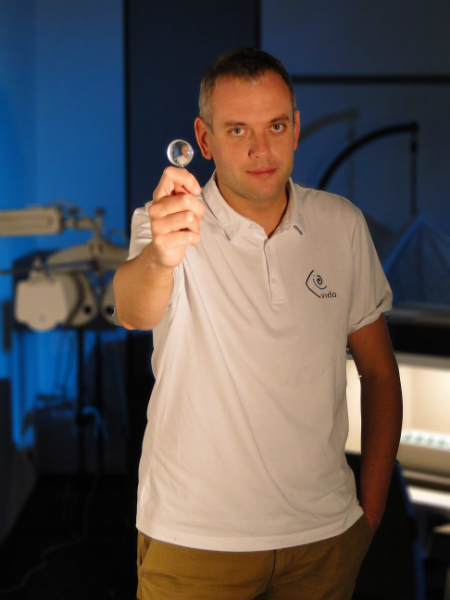Support in diagnostics and treatment of visual impairment

“Our solution will enable the creation of custom corrective devices in the future”, says dr inż. Karol Kakarenko. Photo credit: CZiITT, Warsaw University of Technology
Thorough research, automatic selection of correction methods and testing of new solutions without the costly production of trial glass or contact lenses – these are the key advantages of the device being developed by dr inż. Karol Kakarenko from the Faculty of Physics of the Warsaw University of Technology along with his team. The VIDO project aims to support ophthalmologists and patients, as well as to promote the development of scientific and industrial research.
How will it work in practice? At first glance, neither ophthalmologists nor patients will notice or feel that the eye test is any different than before. The outcome, however, will be different.
“Our device will automatically ‘measure’ the eye with extreme accuracy, and then it will generate any kind of a corrective device on a special display, virtually placing it in or on the eyeball”, dr Karol Kakarenko explains. “The patient will see as if they had the device on their eye, but it will not be necessary to produce and apply the device. For example, before a surgery, the doctor will be able to demonstrate several options to the patient, helping them with the decision about the treatment method.
Virtual corrective lenses will not only optimise the cost-intensive production process, but will also significantly facilitate the conduct of clinical trials prior to the approval of actual devices for use, especially that some solutions, once verified using our device, may not qualify for the implementation stage at all.
Dr Kakarenko is implementing his “VIDO – Improving the quality of vision through dynamic optics” project owing to a grant under the LIDER IX Programme of the National Centre for Research and Development.
The innovation
At present, none of the devices present on the market offer all the capabilities of the solution designed by the scientists from the Faculty of Physics. However, they are aware of the market competition. That is why the project team monitor customer needs and functionalities of commonly available solutions on an ongoing basis. In particular, they point to the Spanish VAO device, created under the direction of Prof. Pablo Artal, as the one that most resembles their project.
“The difference is that the said device works in a closed field, which means that the patient looks at optotypes with digits and letters displayed on screen”, dr Kakarenko explains. “We want the patient to see a broad field, not just the optotypes, but also their natural environment.” This way, it will be possible to test near and distance vision in real-life conditions. The fundamental value of our device will be that it will integrate multiple functionalities into a single algorithm. Most of those functionalities already exist in the form of separate devices, but in our opinion their full potential will not be achieved until they are combined in a single system. However, the dynamic generator of corrective devices will be a certain innovation.
The future
“Our solution will enable the creation of custom corrective devices in the future, instead of choosing glass or contact lenses from an existing portfolio, which is how things are done today”, dr Kakarenko emphasised.
The solution will also promote scientific research and expand the scope of research.
“For example, we will be able to check if too much vision correction will be accepted by the brain”, dr Kakarenko says.
The business context
Scientists take a lot of care to adapt their devices to the needs and expectations of customers, mainly ophthalmologists and medical companies. This is already reflected in the composition of the team, whose members include an ophthalmologist, IT specialist, optician, psychologist and business analyst, to name just some.
“We know that some of our device’s functionalities will be more desirable in clinical ophthalmology, and other in technology labs”, says dr Kakarenko. “To optimise the price of the resulting device and thus improve its availability, we factor in certain feature limitations for specific target customers.”
The project team additionally take care to ensure that the resulting device will not differ significantly in size and manner of operation from the solutions already known to potential users. The first potential business partners have already stated their interest in cooperation.
The VIDO project team works at the newly established Perception Research Laboratory, which is a joint project of the Physics Department and the Research and Analysis Department of the Centre for Innovation and Technology Transfer Management.
Agnieszka Kapela
Promotion and Information Office
Project team: dr inż Karol Kakarenko (Faculty of Physics, Warsaw University of Technology, project manager, module designer and vision optics expert), dr inż. Izabela Ducin (Faculty of Physics, Warsaw University of Technology, projection systems expert), dr Anna Byszewska (Ophthalmology Clinic, Military Institute of Medicine in Warsaw, human trials expert), mgr inż. Jan Bolek (Faculty of Physics, Warsaw University of Technology, automation and robotics expert), mgr Dariusz Parzych (Centre for Innovation and Technology Transfer Management, market research and commercialisation expert), dr inż. Krzysztof Petelczyc (Faculty of Physics, Warsaw University of Technology, promotion expert).
Project duration: 1 January 2019 to 31 December 2021
“VIDO – Improving the quality of vision through dynamic optics”, project funded under the LEADER IX Programme of the National Centre for Research and Development.








